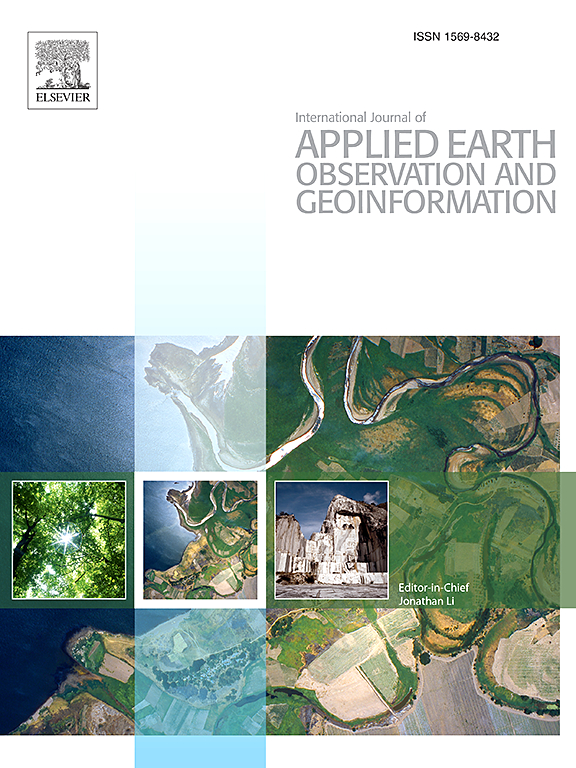A novel approach for snow depth retrieval in forested areas by integrating horizontal and vertical canopy structures information
IF 7.6
Q1 REMOTE SENSING
International journal of applied earth observation and geoinformation : ITC journal
Pub Date : 2024-11-22
DOI:10.1016/j.jag.2024.104278
引用次数: 0
Abstract
Snow cover significantly influences the Earth’s climate system and global hydrological cycle through its thermal insulation properties and high albedo, and is an important component of the cryosphere. Currently, the most efficient means of quantifying snow depth at both global and regional scales is through passive microwave remote sensing. However, the accuracy of passive microwave remote sensing inversion of snow depth in forested areas is affected by the forest canopy. In this study, a normalized maximum stem volume (NMSV) index was constructed by combining canopy height and tree cover data obtained through remote sensing techniques. The NMSV index was then incorporated into development of snow depth retrieval algorithm to improve accuracy of passive microwave snow depth estimation in forested areas. Compared to the Chang algorithm and the AMSR-E snow depth product, this study demonstrated higher accuracy in the mid- to high-latitude forested areas of Eurasia, with an R value approximately twice as high and a reduction in the overall root mean square error (RMSE) by 2.3 cm and 7.2 cm, respectively. The relative mean bias of this study in the Western Russia, the Eastern Siberian Mountains and the Northeast China is significantly reduced than that of the existing remote sensing algorithms. Against the ERA5 and GlobSnow datasets, with the exception of the Western Russia, the performance of this study in the mid- to high-latitude forested areas of Eurasia is comparable to the ERA5 dataset and superior to the other datasets. Based on the performance of the algorithms in different NMSV values, we observe a decline in the accuracy of this algorithm when the value exceeds 0.8, which was caused by small size of high NMSV values among the ground observation sites involved in the development of snow depth retrieval algorithm. Overall, the NMSV index proposed in this study, which integrates information from both the horizontal and vertical structures of forest, can better characterize the microwave radiation properties of sparse and moderately dense forests, facilitating improvements in the accuracy of passive microwave snow depth retrieval in global forested areas.
综合水平和垂直树冠结构信息的林区雪深检索新方法
积雪通过其隔热性能和高反照率对地球气候系统和全球水文循环产生重大影响,是冰冻圈的重要组成部分。目前,在全球和区域范围内量化积雪深度的最有效方法是被动微波遥感。然而,被动微波遥感反演林区积雪深度的精度受到林冠的影响。本研究结合遥感技术获得的冠层高度和树木覆盖率数据,构建了归一化最大茎干体积指数(NMSV)。然后将 NMSV 指数纳入雪深检索算法的开发中,以提高林区被动微波雪深估算的精度。与 Chang 算法和 AMSR-E 雪深产品相比,该研究在欧亚大陆中高纬度林区的精度更高,R 值约为后者的两倍,总体均方根误差(RMSE)分别减少了 2.3 厘米和 7.2 厘米。与现有遥感算法相比,该研究在俄罗斯西部、东西伯利亚山脉和中国东北地区的相对平均偏差明显减小。与ERA5和GlobSnow数据集相比,除俄罗斯西部外,本研究在欧亚大陆中高纬度林区的表现与ERA5数据集相当,优于其他数据集。根据算法在不同 NMSV 值下的表现,我们观察到当 NMSV 值超过 0.8 时,该算法的准确性有所下降,这是由于在开发雪深检索算法时所涉及的地面观测点中,高 NMSV 值的观测点规模较小造成的。总之,本研究提出的NMSV指数综合了森林水平结构和垂直结构的信息,能更好地表征稀疏森林和中等密度森林的微波辐射特性,有助于提高全球林区被动微波雪深检索的精度。
本文章由计算机程序翻译,如有差异,请以英文原文为准。
求助全文
约1分钟内获得全文
求助全文
来源期刊

International journal of applied earth observation and geoinformation : ITC journal
Global and Planetary Change, Management, Monitoring, Policy and Law, Earth-Surface Processes, Computers in Earth Sciences
CiteScore
12.00
自引率
0.00%
发文量
0
审稿时长
77 days
期刊介绍:
The International Journal of Applied Earth Observation and Geoinformation publishes original papers that utilize earth observation data for natural resource and environmental inventory and management. These data primarily originate from remote sensing platforms, including satellites and aircraft, supplemented by surface and subsurface measurements. Addressing natural resources such as forests, agricultural land, soils, and water, as well as environmental concerns like biodiversity, land degradation, and hazards, the journal explores conceptual and data-driven approaches. It covers geoinformation themes like capturing, databasing, visualization, interpretation, data quality, and spatial uncertainty.
 求助内容:
求助内容: 应助结果提醒方式:
应助结果提醒方式:


